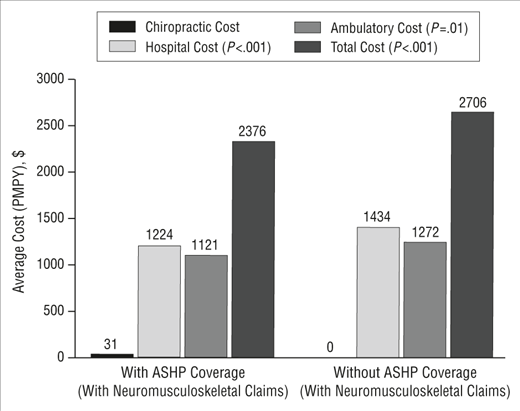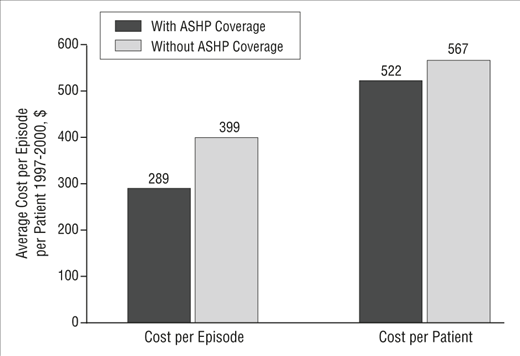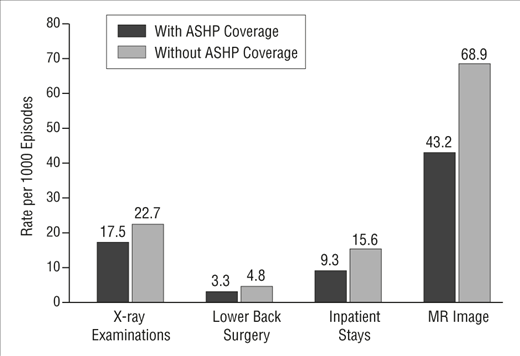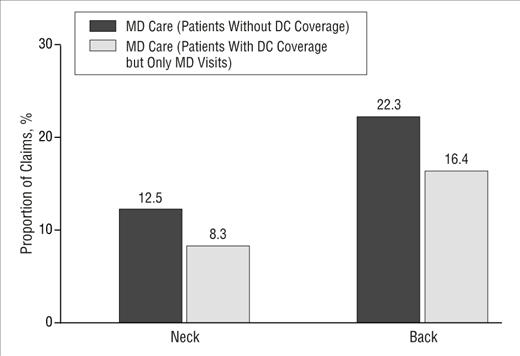

Comparative Analysis of Individuals
With and Without Chiropractic Coverage:
Patient Characteristics, Utilization, and CostsThis section is compiled by Frank M. Painter, D.C.
Send all comments or additions to: Frankp@chiro.org




FROM: Archives of Internal Medicine 2004 (Oct 11); 164 (18): 985–1892 ~ FULL TEXT
OPEN ACCESS Antonio P. Legorreta, MD, MPH; R. Douglas Metz, DC; Craig F. Nelson, DC, MS;
Saurabh Ray, PhD; Helen Oster Chernicoff, MD, MSHS; Nicholas A. DiNubile, MD
Department of Health Services,
UCLA School of Public Health,
Los Angeles, Calif
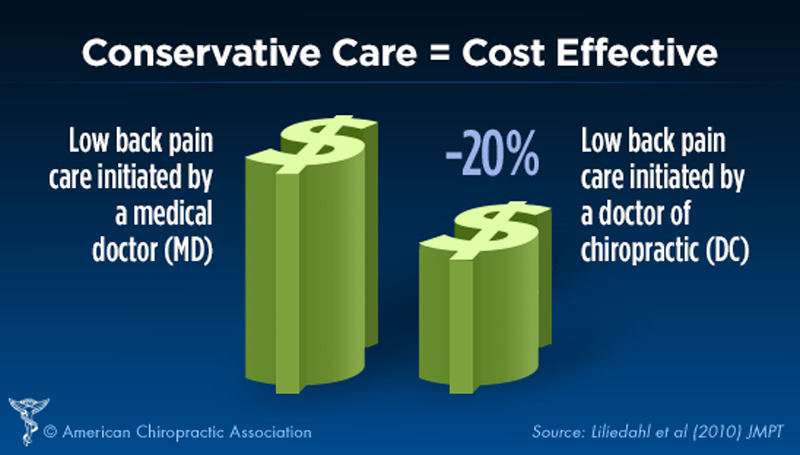
FROM: Liliedahl ~ JMPT 2010 (Nov)
This 4-year retrospective review of claims from 1.7 million health plan members were analyzed to determine the cost effects of the inclusion of a chiropractic benefit in an HMO insurance plan. The data revealed that members with a chiropractic benefit had lower overall total annual health care costs. Back pain patients with chiropractic coverage also realized lower utilization of plain radiographs, low back surgery, hospitalizations and MRI’s. Back pain episode-related costs were also 25 percent lower for those with chiropractic coverage ($289 vs. $399).
BACKGROUND: Back pain accounts for more than $100 billion in annual US health care costs and is the second leading cause of physician visits and hospitalizations. This study ascertains the effect of systematic access to chiropractic care on the overall and neuromusculoskeletal-specific consumption of health care resources within a large managed-care system.
METHODS: A 4-year retrospective claims data analysis comparing more than 700,000 health plan members with an additional chiropractic coverage benefit and 1 million members of the same health plan without the chiropractic benefit.
RESULTS: Members with chiropractic insurance coverage, compared with those without coverage, had lower annual total health care expenditures ($1463 vs $1671 per member per year, P<.001). Having chiropractic coverage was associated with a 1.6% decrease (P = .001) in total annual health care costs at the health plan level. Back pain patients with chiropractic coverage, compared with those without coverage, had lower utilization (per 1000 episodes) of plain radiographs (17.5 vs 22.7, P<.001), low back surgery (3.3 vs 4.8, P<.001), hospitalizations (9.3 vs 15.6, P<.001), and magnetic resonance imaging (43.2 vs 68.9, P<.001). Patients with chiropractic coverage, compared with those without coverage, also had lower average back pain episode-related costs ($289 vs $399, P<.001).
CONCLUSIONS: Access to managed chiropractic care may reduce overall health care expenditures through several effects, including (1) positive risk selection; (2) substitution of chiropractic for traditional medical care, particularly for spine conditions; (3) more conservative, less invasive treatment profiles; and (4) lower health service costs associated with managed chiropractic care. Systematic access to managed chiropractic care not only may prove to be clinically beneficial but also may reduce overall health care costs.
From the FULL TEXT Article:
INTRODUCTION
In the United States, back pain is the second leading cause of physician visits and is second only to childbirth for hospitalizations. [1] It is also the most prevalent chronic medical problem, the number one cause of long-term disability, and the second most common cause of restricted activity and use of prescription and nonprescription drugs. [2, 3] Ten years ago health expenditures for chronic back pain were estimated to be $50 billion to $100 billion annually, [4] and studies [1, 3] suggest expenditures have risen exponentially since that time. Epidemiologic studies also indicate an upward trend for back pain in both men and women, [5] a trend that is likely to continue as the average age of the US population continues to increase.
EFFICACY AND SAFETY OF CHIROPRACTIC CARE FOR BACK PAIN
There is evidence supporting the efficacy of chiropractic care for back pain. A comprehensive review [6] of the literature evaluating the efficacy of chiropractic treatments for low back pain and other conditions reported that randomized control trials "show spinal manipulation to be better, and no trial finds it to be significantly worse, than conventional treatment." [6](p2220) Despite a number of methodologic limitations in some of the investigations, [6] an overview of the literature, including clinical trials, case-control studies, and meta-analyses, reflects favorably on the efficacy of chiropractic care relative to conventional medical treatment for back pain. [1, 3, 5, 7–14]
Although serious complications from spinal manipulation therapy have been reported in a small proportion of chiropractic patients, [15] for most of the population, chiropractic treatment is associated with a relatively low risk level, on par with conventional medical treatments. [5, 16] On the other hand, comprehensive overview of the literature reveals that it is essentially unanimous in reporting that chiropractic care is associated with significantly higher patient satisfaction compared with patients who receive conventional treatments. [17–20]
COST EFFECTIVENESS OF CHIROPRACTIC CARE
Several studies [5] have produced preliminary evidence demonstrating cost-effectiveness of chiropractic compared with medical management. A series of studies by Stano and colleagues [21–24] and one study by Dean and Schmids [25] report cost benefits of chiropractic care compared with conventional medical treatment for neuromuscular conditions in a review of current literature (mostly workers' compensation studies). For instance, a 1996 cost comparison study, [23] which adjusted for demographic, insurance, and condition variables, revealed higher total (30% to 217% higher) and outpatient (27% to 94% higher) mean payments of medical treatment relative to chiropractic treatment. These later studies support the applicability of findings to managed health care settings by including large sample sizes and examining existing fee-for-service health claims data.
In contrast, a study by Carey et al [26] found significantly higher health care costs for patients with chiropractic or orthopedic care for back pain (secondary to a greater number of visits) than for patients who received their back pain care from a primary care physician at a health maintenance organization. Patients were interviewed over the telephone for up to 24 weeks to assess use of health care services and outcomes of care. Patients who received care from doctors of chiropractic care (DCs) paid more per episode than patients who received care from primary care physicians (69% in urban setting and 3% in rural setting). However, in this study the analyses were limited to outpatient costs rather than total costs; the costs were estimated using average statewide charges for a large insurance carrier; and, although the analyses adjusted for sciatica, baseline functional status, and duration of pain, [20] the study did not specifically adjust for the variables comorbidities, severity, and type of diagnosis.
Another study [6, 27] that compared cost of care for episodes of back pain between various kinds of medical practitioners (orthopedists and chiropractors) found differential costs for care compared with care provided by a general medical practitioner. This study, however, based analyses on data collected up to 25 years ago and thus may not be applicable to today's health care market. In addition, these studies were characterized by small sample sizes, increasing the probability of type II errors (failure to find a real difference between groups). Given the discrepant cost-effectiveness findings and significant methodologic differences that limit study comparisons, the issue of the benefit of chiropractic care in today's health care system remains unresolved.
ACCESS TO CHIROPRACTIC CARE
Chiropractors now represent the third largest segment of health care practitioners in the United States, [1] with 50,000 practitioners in 2000 according to the Bureau of Labor Statistics. [28] According to the American Chiropractic Association, an estimated 21 million to 28 million people now receive chiropractic services each year, with approximately 192 million annual visits to DCs: between 1990 and 1997, chiropractic use increased from 10% to 11%. [29] With growing public demand, [30] the profession is also expected to increase 21% to 35% by 2008. [16]
A recent study [31] of employers in large companies shows that chiropractic insurance coverage is now being offered to most American workers who are covered by health insurance and is increasingly being offered in all health plan types. This and other studies [32] note that although health insurance for chiropractic services is expanding, insurers often restrict coverage to manage risk.
Chiropractic coverage is often limited in terms of referral restrictions, conditions covered, number of visits, maximum annual dollar benefit, requirement for physician referral, and amount paid per visit. Some plans do not provide covered benefits but instead offer a network program in the form of discounted services. Health plan designs may impede appropriate access to chiropractic clinical care and may diminish the strength DCs have in treating neuromusculoskeletal (NMS) disorders.
The disconnect between evidence regarding the efficacy and safety of chiropractic care, consumer demand, and the limited research on cost of chiropractic care in applied settings has served to hinder integration of chiropractic coverage in traditional health care services. To help bridge this divide, improve access to appropriate chiropractic services, and promote best practices of chiropractic care, there is a need for community-based research to ascertain the effect and benefits of chiropractic care and the associated utilization of health care resources.
The data analyzed in this study were obtained from a natural experiment setting. A natural experiment is an experiment conducted in real-life setting rather than the controlled environment, where researchers "rely on truly naturally occurring events in which people have different exposures that resemble an actual experiment." [33](p150) In this case, the data were collected and analyzed from a naturalistic setting rather than a laboratory setting. Although this is not a true experiment, such an approach is common in health services research because of the high external validity and generalizibility of the results obtained from studies that used natural experiment methods.
This study was conducted to identify and describe the demographics, disease, and utilization patterns of individuals with access to chiropractic care compared with individuals without such coverage. Toward this end, this study compared members of the same health plan, both with and without an additional chiropractic benefits rider. This natural experiment offers a particularly rich opportunity to understand the effects of supplemental chiropractic coverage on utilization of medical care because it employs members of the same health plan as a comparison group. Both groups studied were members of the same large managed-care system with access to the same physician network; with the same or similar covered benefits; with the same rules on referral to specialty care, high-cost diagnostic tests, and hospital and surgery approval guidelines; and with the same exclusions and limitations.
METHODS
STUDY POPULATION
This 4–year study (April 1, 1997, to March 31, 2001) used administrative claims data from a large regional managed-care network in California. These data included inpatient and outpatient data for more than 1.7 million continuously enrolled members containing demographic and enrollment information in addition to diagnosis and procedure codes as classified under the International Classification of Diseases, Ninth Revision (ICD-9) and the Current Procedural Terminology, Fourth Edition. Administrative claims data from the largest chiropractic health plan in California, American Specialty Health Plans, were used to subsequently identify approximately 700 000 of the 1.7 million patients enrolled in the large managed-care organization who also received additional chiropractic coverage through an American Specialty Health Plans benefits rider. These 700 000 members who were enrolled in both plans and had access to a medical and chiropractic network of practitioners were compared with the 1 million members who were enrolled in the managed care network only. For those members enrolled in both plans, the administrative claims data from the 2 networks were merged into one unique administrative file, thereby creating 2 main comparative cohorts from the same large health plan: one with access to chiropractic care and the other without. The former group had benefits covering direct access to a DC without the need of a physician referral. Under this benefit plan the patient copay for a chiropractic office visit was the same as it would be in a medical clinic. The benefit allowed for a maximum of 40 office visits to a DC per year.
STUDY DESIGN
This study applied a retrospective, longitudinal, quasi-experimental, participant-nonparticipant design. The carve-out feature of the chiropractic insurance coverage offered by the managed-care health plan as an option to its employer groups was used to create retrospective control cohorts at 3 different levels.At the first level, managed care members with chiropractic insurance coverage were compared with the members in the same health plan without chiropractic coverage.
At the second level, we compared members with and without chiropractic coverage but only if they had had NMS claims at any time during the study period.
At the third level, we compared episodes of care for members with NMS conditions receiving care only from DCs against members with NMS claims receiving care only from medical doctors (MDs).The effect of adding a chiropractic benefit on the health plan's overall resource consumption was assessed over a typical horizon for employer-sponsored health insurance. To achieve this, the observation period and analyses were annualized to a study period from January 1 to December 31, 2000, when assessing group differences in demographics, comorbidities, and total plan claim expenditures.
However, to comprehensively compare the effects of treatment for NMS conditions between DCs and MDs, a longer observation period was appropriate, because NMS conditions are typically time limited but recurrent and can manifest over multiple episodes spanning a longer period. Therefore, we expanded our analysis period across 4 years from April 1, 1997, to March 31, 2001, to study the costs and utilization patterns associated with NMS episode–specific care.
To enable meaningful comparisons of utilization and costs of medical and chiropractic care for categories of NMS disorders based on anatomic and clinical similarity, a classification system grouping individual ICD-9 codes for NMS conditions into more aggregative diagnosis groups was developed for this study. The classification also took into account the severity of specific conditions such as neck and lower back diagnoses. A total of 654 ICD-9 codes, identified by separate panels of DCs and MDs as NMS conditions most commonly treated and eligible for insurance coverage, were sorted into the following categories:neck,
lower back,
thoracic spine and rib disorders,
headache,
upper extremity,
lower extremity,
myalgias or arthralgias,
latent effects,
and other.Additionally, severity distinctions were made for neck and lower back diagnoses by sorting into complicated and uncomplicated conditions, thus extending the diagnostic groups to 11. The ICD-9 codes for these diagnostic groups were comprehensively reviewed for possible inclusions, exclusions, and crossover by a panel of DCs and medical NMS experts.
To maximize comparability between medical and chiropractic coding, a subanalysis was performed to examine a small group of codes that would be equally applicable to chiropractic and medical practice. This set of codes was selected for its high frequency of occurrence in both medical and chiropractic cohorts. To level the playing field between chiropractic and medical care for these low back pain–specific analyses, cases that were associated with any claims for back surgery were excluded from the subanalysis, because such cases are likely to have complications for which chiropractic care would not be appropriate.
DEFINING EPISODES OF CARE
In addition to encounter-specific comparisons, entire episodes of care were of interest in the study. For each member with at least 1 NMS claim or a sequence of NMS claims, an episode of NMS care was determined by the diagnosis group of the sequence of claims and an allowable gap between any 2 consecutive claims of less than 45 days. Claims separated by 45 days or more were considered separate episodes. The 45–day interval was derived from a previous study [20–22] that used the 9 most common ICD-9 codes for low back pain to evaluate the percentage of treatment encounters that were captured using different intervals to terminate an episode. The study found that for the most common ICD-9 code (724.2) an interval of 6 weeks (42 days) captured 86% of all encounters, and the remaining 8 diagnoses yielded values ranging from 42 to 49 days. A sensitivity analysis of these values demonstrated that there was little change in the overall study results if these values were moved upward or downward. Based on these results and on the clinical consensus of an expert panel of both DCs and MDs, a value of 45 days was judged to be appropriate. For neck- and back-related episodes, which were stratified into complicated and noncomplicated diagnosis groupings, any switch in diagnosis between uncomplicated and complicated neck-related conditions during the 4–year sample period triggered the entire sequence of claims to be identified within the complicated neck diagnosis grouping.
OVERALL EXPENDITURES AND UTILIZATION
The primary health care expenditures considered for this study were total health care claim expenditures, individual components of total health care claim costs such as those associated with inpatient and outpatient services, and costs associated with NMS care at the episode level. Utilization metrics included the following:outpatient services,
plain radiographs,
magnetic resonance (MR) images,
lumbar spine surgical procedures,
and inpatient stays.Health risk characteristics, based on demographics and comorbidity rates, were used to compare the risk profiles for different groups. The health plan expenditures from inpatient, outpatient, and chiropractic outpatient paid amounts were used in the calculation of health care costs and reflect the dollar value of the payers' resource consumption in providing access to medical and chiropractic care to its members. Prescription claims and physical therapy claims were not included during this phase of the ongoing study, and therefore pharmacy and physical therapy costs were not included in health care costs.
STATISTICAL ANALYSIS
Descriptive statistics, including mean values, standard deviations, and column percentages, were computed and average differences between groups were evaluated. We used X2 tests to evaluate differences between categorical variables. This included variables with proportional values, such as sex, proportion of patients in the comorbidity and diagnosis groups, and proportion of complicated episodes. To test the difference in mean values for continuous variables, such as age and costs, and to account for the skewed distribution of variables, we applied nonparametric analysis of variance instead of conventional parametric tests such as t tests. We applied the Wilcoxon test when comparing 2 cohorts and the Kruskal-Wallis test when comparing 3 cohorts.
A semilogarithmic regression model was also used to estimate the effect of chiropractic insurance coverage on total annual health care expenditures. The total health care costs of plan members with positive utilization during calendar year 2000 were regressed on their chiropractic coverage status, after adjusting for their demographic, NMS, and comorbid characteristics using the following specification:
The logarithmic transform of the total health care costs was used as the dependent variable to correct for nonnormality and heteroscedasticity in the cost distribution. The comorbidity score, computed as the number of comorbid conditions that a member was identified with during the annual period, was used as a risk adjuster in addition to age, sex, and presence of a NMS condition. The primary independent variable of interest was the dummy variable, which was equal to 1 if the member had chiropractic coverage during the period and equal to 0 if otherwise. The antilog of the estimated regression coefficient, after accounting for its variance, was used to estimate the effect of chiropractic coverage on the annual total health care costs of the health plan as follows: [34]
where Var(β) is the squared standard error of the estimated regression coefficient β1.
RESULTS
COMPARISON OF MEMBER COHORTS

Table Year 2000 claims for 707,690 health plan members with chiropractic coverage and 1,001,995 members without chiropractic coverage were compared. Demographic characteristics and comorbid conditions for members with and without chiropractic insurance coverage are displayed in the Table.
Members with chiropractic coverage were younger (mean age, 33 years) than members without chiropractic coverage (mean age, 36; P<.001). The cohort without chiropractic coverage contained a slightly higher percentage of female members (52.1% female) than the cohort with chiropractic coverage (51.6% female, P<.001).
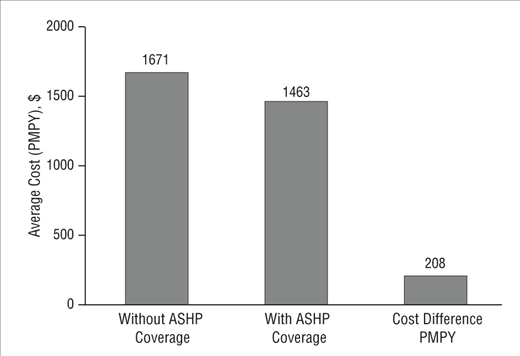
Figure 1 Members with chiropractic coverage also were less likely than members without chiropractic coverage to have comorbid medical conditions. The proportions of members who had specific comorbid conditions, including hypertension, diabetes, cardiac arrhythmias, heart failure, and nutritional disorders, ranged from 0.6% to 6.5% in the population with chiropractic coverage and 0.9% to 7.3% in the population without coverage (P = .001 for each comparison). In particular, heart failure (0.6% vs 0.9%), cardiac arrhythmias (1.6% vs 2.0%), and hypertension (6.5% vs 7.3%) were lower in relative occurrence in the member population with chiropractic coverage. Annual total health care claim costs of the member populations with and without chiropractic coverage for year 2000 are presented in Figure 1. The per-member-per-year (PMPY) cost of members with chiropractic coverage was $1463, which was $208 lower (P<.001) than the PMPY cost of members without the coverage ($1671). This translates to a 12% reduction in annual costs incurred by the managed care organization on members with chiropractic coverage.
COMPARISON OF NMS PATIENT COHORTS
The 141 616 patients with NMS conditions who had chiropractic coverage were also compared to 189 923 NMS patients without chiropractic coverage. As with members with and without chiropractic coverage, NMS patients with chiropractic coverage were younger (mean age, 41 years) than NMS patients without chiropractic coverage (mean age, 44 years; P<.001). Similarly to members with and without chiropractic coverage, NMS patients with chiropractic coverage were less likely than NMS patients without chiropractic coverage to have comorbid medical conditions (P<.001 for each of the comorbid conditions previously mentioned).
The overall medical expenditures of the patients with NMS conditions during the year 2000, including the major components of the expenditures, are presented in Figure 2. The PMPY cost of NMS patients with chiropractic coverage was $2345, which was $361 lower (P<.001) than the PMPY cost of NMS patients without the coverage ($2706). This translates to a 13% reduction in annual costs incurred by the health plan on NMS patients with chiropractic coverage.
Annual per capita hospital cost for NMS patients with chiropractic coverage ($1224) was $210 lower or 15% (P<.001) than that for NMS patients without chiropractic coverage. The annual per capita ambulatory cost for NMS patients with chiropractic coverage ($1121) was 12% lower (P = .01) than the corresponding cost for NMS patients without chiropractic coverage ($1272). The annual per capita cost of providing chiropractic care was $31, which amounted to only 1% of the total dollar value of resources consumed ($2376) by NMS patients between the 2 cohorts.
To adjust for age, sex, presence of an NMS condition, and comorbidity differences between cohorts, a semilog regression analysis was also used to estimate the impact of chiropractic care as a covered benefit on total health care costs of the health plan for year 2000. The estimated coefficient for chiropractic coverage indicator (ß1) was –0.0162. The regression results indicate that the presence of chiropractic insurance coverage was systematically associated with an approximately 1.6% lower (P = .001) average total health care cost of members, after controlling for differences in age, sex, and the number of comorbidities. The 1.6% reduction in total health care costs per member is equivalent to approximately 13% of the $208 PMPY observed cost difference reported in Figure 1. This translates to an approximately $27 PMPY potential cost saving that can be attributed to the presence of chiropractic insurance coverage in the plan, after accounting for differences in demographic and comorbidity risks of the members.
BACK PAIN–SPECIFIC TREATMENT
Figure 3 presents data related to the cost of providing care for back pain, at an episode level, for the 4–year period (April 1, 1997, to March 31, 2001). The average cost per back pain episode for patients with chiropractic coverage was $289, which was $110 or 28% lower (P<.001) than for back pain patients without chiropractic coverage. Aggregating episodes for each patient during the 4–year period, the average cost of back pain treatment for patients with chiropractic coverage was $522, which was $45 or 8% lower than the corresponding back pain treatment cost for patients without chiropractic coverage.
Furthermore, the proportion of complicated back pain episodes was only marginally higher (10% vs 8%, P<.001) for patients who received care only from MDs compared with the patients who received care only from DCs.
Utilization rates for back pain episodes presented in Figure 4 indicate significantly lower utilization of resources across all major high-cost areas for NMS patients with chiropractic insurance coverage compared with those without. Back pain patients with chiropractic coverage had fewer inpatient stays than did those without chiropractic coverage (9.3 vs 15.6 stays per 1000 patients, P<.001). The MR image rate was also lower for back pain patients with chiropractic coverage compared with those without chiropractic coverage (43.2 vs 68.9 MR images per 1000 patients, P<.001). The rate of lower back surgery among patients with chiropractic coverage was lower as well (3.3 vs 4.8 surgical procedures per 1000 patients, P<.001). Back pain patients with chiropractic coverage also received fewer radiographs (17.5 vs 22.7 per 1000 patients, P<.001) than did back pain patients without chiropractic coverage.
SUBSTITUTION EFFECTS
Figure 5 presents the distribution of NMS claims reported for neck and back pain episodes during the 4–year period. This table compares 2 groups of patients, both who sought care for NMS complaints from MDs only. However, members of one of the groups were limited by the absence of access to chiropractors within the plan due to lack of chiropractic insurance coverage. The proportion of neck complaints seen by MDs for patients with chiropractic coverage was 8.3%, 4 percentage points lower (P<.001) than for the corresponding proportion for patients without chiropractic coverage. Similarly for back pain, the proportion of complaints seen by MDs for patients with chiropractic coverage was 16.4%, 6 percentage points lower (P<.001) compared with patients without coverage. Correspondingly, a very high rate (approximately 60%) was also observed for the proportion of neck and back complaints seen by the network DCs during the same period. This suggests a substitution of DC care for MD care for neck and back complaints.
COMMENT
The high prevalence and recurrent incidence of back pain, as well as the heavy economic and disability burden that it imposes on society as documented in the literature, point to a major area of public health concern. Simultaneously, there is growing evidence for the low risks associated with chiropractic spinal manipulation in most cases and favorable evidence for its effectiveness in treating low back pain. In addition, patients treated for back pain by DCs tend to be more satisfied than patients treated by MDs. However, despite this evidence for safety, effectiveness, and growing public demand, health insurance coverage for chiropractic care continues to remain restricted, relative to other health services, particularly in the managed care sector.
This restriction of access to health insurance for chiropractic care is not due to a lack of DCs, however. Rather, chiropractic care is becoming increasingly prevalent in the American health care system. The increasing acceptance of chiropractic care as a source of comprehensive complementary care for NMS problems is reflected in that the chiropractic field is the fastest growing among all doctoral-level health professions. [17]
To date, there has been little research linking chiropractic and medical utilization data at a patient level. Thus, a powerful opportunity to compare the effects of chiropractic and medical management of costly NMS conditions, such as back pain, in a real-world managed care setting has been underused. This study integrated and analyzed comprehensive administrative data from a large managed medical care organization and the chiropractic care plan that provided an additional chiropractic benefit to more than 40% of its members. By comparing members within the same medical managed care plan both with and without direct access to chiropractic care, this study provides additional information on the effect of chiropractic insurance benefits on the resource utilization within a managed care network.
For the managed care plan studied, the presence of a supplementary chiropractic insurance option was associated with favorable member selection by the plan. This is evident in that members with covered chiropractic benefits were significantly younger and had less comorbidity burden. This favorable selection could have been an artifact of 2 factors that reflect employer and employee preferences. The larger companies in particular, in the interest of maintaining a large productive workforce, may have been likely to offer additional benefits, such as supplementary insurance, to attract younger and healthier individuals. At the same time, potential employees, particularly those who maintain a healthier lifestyle may have been more likely to seek employment in companies that offer benefits covering complementary care (eg, chiropractic or acupuncture) that can be perceived as less aggressive treatment modalities.
This study found that members with chiropractic coverage had a 12% lower annual medical care cost, not adjusting for member risk characteristics. After controlling for the cost-saving effects associated with favorable demographic and medical risk factors, the regression analysis found a statistically significant 1.6% reduction in total medical care costs that can be isolated to the presence of chiropractic coverage. Most of this 1.6% reduction in the plan's total medical costs is likely derived from the 13% reduction in the total medical costs observed for the subset of members with NMS conditions who also had chiropractic coverage. In our study population of 0.7 million members who had chiropractic coverage in the medical plan, we estimated an annual reduction of approximately $16 million as a result of lower utilization of high-cost items. This is a conservative estimate of the cost savings for the plan that can be associated with members in the medical plan using their supplementary benefits to seek chiropractic treatment of their NMS problems. The estimated cost saving appears to more than offset the amount spent to cover the associated costs of the chiropractic benefit.
The analyses related to NMS episodes elucidate sources of these cost savings relating to chiropractic treatment of common NMS complaints, such as neck and back pain. Focusing on low back pain diagnoses that were selected specifically for comparability between medical and chiropractic practice, our analysis found that patients with chiropractic coverage had significantly lower rates of use of resource-intensive technologies, such as x-ray examinations, MR image, and surgery, and lower use of more expensive patient care settings, such as inpatient care. This is reflected in the significantly lower cost, at both the episode level and the patient level, of providing care for back pain. The difference in episode-specific and patient-level resource utilization did not seem to be due solely to a difference in severity of cases seen by DCs and physicians, since the estimated 2% difference in severity between chiropractic and medical patients of back pain did not constitute a clinically meaningful difference. In addition, the substitution of chiropractic for physician care evident from the shift in the case distribution between physicians and DCs when chiropractic coverage was present also contributed to the conservation of health care resources.
Although the results from the study may carry policy implications in the managed care industry, the limitations of this study are worth noting, especially since they also open up avenues for future research. This study only analyzes effects of chiropractic coverage in a large but specific managed care population. Future research covering geographically diverse populations across several plans is needed to ascertain and validate the effect of a chiropractic benefit on utilization patterns and cost effects, after controlling for differences arising from factors, including location, plan-specific benefit design, industry type, and other undetected biases, such as patient burden of disease. Comorbidity score and demographic characteristics such as age were controlled for in the regression model. However, the significantly more favorable profile of the plan members who selected chiropractic coverage poses some concern regarding the generalizability of the results to a sicker, older population. Especially as the average age of the American population continues to increase in the next decade, the safety and appropriateness of chiropractic care for elderly patients will need to be more thoroughly evaluated. Further research is also necessary to quantify utilization and costs associated with DC vs MD care for other NMS conditions, and to ascertain clinical outcomes for specific NMS conditions.
The substitution of chiropractic utilization for medical care is central to the issue of providing cost-effective care for NMS conditions in a managed care environment, since the provision of chiropractic benefits as supplementary insurance raises the possibility of induced demand for medically unnecessary care. This study found evidence that a substantial portion of the chiropractic care sought by the members with insurance coverage was more often substituted for medical care rather than add-on care. Further research is needed to quantify this substitution effect. The effects of substitution of chiropractic care utilization for medical care could be further pursued by analyzing data on patients with episodes of NMS care comanaged by DCs and MDs, which was beyond the scope of this study. Although most back pain patients have nonspecific syndromes, a few back pain cases are caused by severe underlying conditions. Accurate diagnosis and appropriate referral are essential for this subset of low back pain cases and demand an integrative approach. This point is especially important in light of the substitution between DCs and internists found by this study. Finally, questions continue to remain regarding the effectiveness of chiropractic care relative to the cost of care and quality of the health care received. Future research using patient surveys (quality-of-life and patient satisfaction measures) in conjunction with medical record review are warranted to further evaluate the cost-effectiveness of chiropractic care in managed care settings.
This study provides additional information regarding the economic benefits and utilization patterns associated with systematic access to chiropractic care. Furthermore, it offers an integrated baseline (combining chiropractic and medical utilization claims data for a common cohort of members) for future research evaluating the effect of alternative clinical management approaches to medical conditions (ie, back pain specifically) with high direct and indirect consumption of medical resources and a high derivative societal cost given the absenteeism and burden of disease associated with them.

Return to LOW BACK PAIN
Return to COST-EFFECTIVENESS
Return to COST EFFECTIVENESS JOINT STATEMENT
Since 10–14–2004


| Home Page | Visit Our Sponsors | Become a Sponsor |
Please read our DISCLAIMER |


